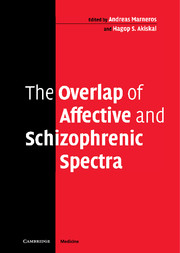Book contents
- Frontmatter
- Contents
- List of contributors
- Preface
- 1 The paradigma of overlapping affective and schizophrenic spectra: schizoaffective conditions
- 2 The overlapping of the spectra: overlapping genes and genetic models
- 3 The continuum of psychosis and its genetic basis
- 4 Functional psychoses: molecular-genetic evidence for a continuum
- 5 State- and trait-related deficits in sustained attention in bipolar disorder: are there any overlaps with schizophrenia?
- 6 The concept of schizoaffective disorder: utility versus validity and reliability – a transcultural perspective
- 7 Phenomenological approaches to the schizoaffective spectrum
- 8 Clinical course of schizoaffective disorders
- 9 Depressive syndromes in schizophrenia
- 10 The overlapping of the spectra: brief and acute psychoses
- 11 Overlapping of the spectra: physical comorbidity between schizophrenia and affective disorders
- 12 The overlapping of the spectra suicide
- 13 Biological treatment of schizoaffective disorders
- 14 Psychological therapies and schizoaffective disorders
- Epilogue: The interface of affective and schizophrenic disorders: a cross between two spectra?
- Index
6 - The concept of schizoaffective disorder: utility versus validity and reliability – a transcultural perspective
Published online by Cambridge University Press: 02 September 2009
- Frontmatter
- Contents
- List of contributors
- Preface
- 1 The paradigma of overlapping affective and schizophrenic spectra: schizoaffective conditions
- 2 The overlapping of the spectra: overlapping genes and genetic models
- 3 The continuum of psychosis and its genetic basis
- 4 Functional psychoses: molecular-genetic evidence for a continuum
- 5 State- and trait-related deficits in sustained attention in bipolar disorder: are there any overlaps with schizophrenia?
- 6 The concept of schizoaffective disorder: utility versus validity and reliability – a transcultural perspective
- 7 Phenomenological approaches to the schizoaffective spectrum
- 8 Clinical course of schizoaffective disorders
- 9 Depressive syndromes in schizophrenia
- 10 The overlapping of the spectra: brief and acute psychoses
- 11 Overlapping of the spectra: physical comorbidity between schizophrenia and affective disorders
- 12 The overlapping of the spectra suicide
- 13 Biological treatment of schizoaffective disorders
- 14 Psychological therapies and schizoaffective disorders
- Epilogue: The interface of affective and schizophrenic disorders: a cross between two spectra?
- Index
Summary
Historical background
Anthropologists, historians, and students of cross-cultural psychiatry have observed that every society has its own view of health and illness as well as its own classification of diseases (Okasha, 1988).
Ever since the recognition by psychiatrists that clusters of symptoms repeatedly occur together, share a similar prognosis and often respond to the same lines of management, attempts have been made to find labels for these clusters. The labels tend to vary and increase in number every time a point of differentiation is recognized or believed to be recognized within these clusters. As the addition of labels was evidence of creative research in psychiatry, mental disorders and syndromes increased in number, and psychiatry seemed to enjoy the pride of having a name for almost every mental and psychological phenomenon. Yet psychiatrists were soon to recognize the drawbacks of such diversity in names and labels: they frequently seemed not to be speaking the same language and an insight was gained into the need for unifying psychiatric classification terms to enable the exchange of information and advice between psychiatrists worldwide. It was recognized that this is a difficult task, because the absence of physical signs and laboratory abnormalities in many mental disorders makes them much more dependent on the consensus of what is normal in a given society, what is abnormal, what is asocial and what is part of a disease (Sartorius, 1990).
- Type
- Chapter
- Information
- The Overlap of Affective and Schizophrenic Spectra , pp. 104 - 132Publisher: Cambridge University PressPrint publication year: 2006



